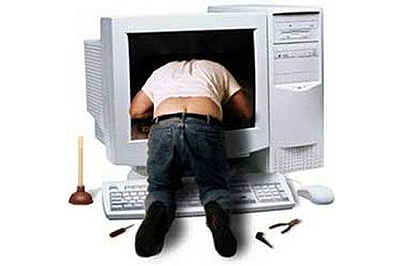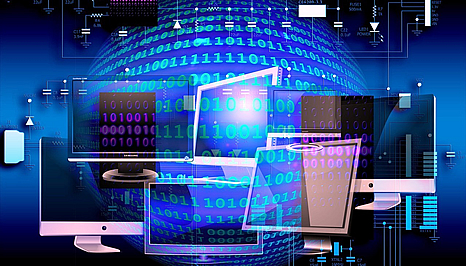Common issues…
- Slow Internet: Here is one of the most common problems facing most users that are connected either through a modem or broadband connection to the Internet. Unfortunately, it is also the most daunting, convoluted, and frustrating problem to rectify due to the many points of failure to take into consideration. Both internal and external issues can exist. For example, it may be a main router down and packets are being diverted in an irregular fashion. It may also be your network interface card that is dropping the connection. It could be your ISP, maybe a DNS server is down or maybe it’s your own router dropping the connection and yet again, it may be you have malware/virus turning your machine into a zombie and chewing up all your bandwidth. Your computer could be running out of hard disk space or memory. Many options to look at to fix one simply stated problem. Unless your willing to put up with the headaches and know what you are looking for, leave this one for someone else to work on.
- Slow computer: This issue can also be a pain to pinpoint using some of the same reasons and logic as mentioned above. You can at least start with the basics and start to eliminate some of the more obvious problems. Defragging the hard drive that your operating system (OS) is on would be a good start. Monitor your memory usage and page filing to the hard drive. If the percentage of your memory usage is high, let’s say above 60% to 80% on a regular basis, you may need to upgrade your memory. Same can be said if you find the hard drive being utilized a lot for page filing, virtual memory. This is referred to as disk thrashing. You’ll notice a lot of activity on your hard drive, the indicator light will be flickering on and off at a relatively high speed, even when you’re not using the computer. Could also be related to malware/virus issues. Corrupted files, bad sectors on the hard dive and so on.
- Computer no longer boots: Corrupted Master Boot Record (MBR), bad entry in the boot.ini file, virus, corrupt registry or a combination of one or the other. Hard drive failure, bad Random Access Memory (RAM), power supply or incompatible software installed could also be contributing factors. Depending on the OS, the approach to fix this issue is the same as any other. Start with the most obvious or common problems and eliminate them one at a time. Systematically going through each scenario and point of failure and making sure that each are working properly. For example, you could try booting into dos and check to see if the file system and files are still there. Boot into your installation CD, floppy, or flash drive and try to manually fix the MBR. Take the hard drive or RAM out and test it in a machine you know already works. Step by step until the problem reveals itself.
- Computer shuts down for no reason: Here we are looking at basically four issues of concern. The power supply, motherboard, Central Processing Unit (CPU), or RAM. If your heatsink or fan is clogged with dirt and dust, the heat being generated by the CPU can not dissipate quickly enough to keep it from overheating. The solution is to clean it either by taking it apart and manually doing so or using a can of compressed air. If the heatsink/fan is not installed properly, being loose, or the contact between them is not correct, possibly the compound not properly applied, these can all contribute to the CPU overheating and shutting down your computer prematurely to avoid further damage. Another possibility, if you have extra hardware such as extra hard drives and/or dual video cards, extra fans that are drawing a lot of power and your power supply is inadequate, this can also cause your computer to shut down.
- Virus/Malware removal: Malware and viruses have singularly targeted Microsoft Windows operating systems since the beginning of time. Well since the early 1980’s anyway. The best way to avoid being infected in the first place is to use some common sense and insure you have a good anti-virus program that is up to date on the latest virus definition files. Make sure you have it installed before you go on the Internet. Avoid sites that you are not familiar with, don’t download programs unless you are 100% certain of their origin and don’t open email attachments that are unfamiliar or have not gone through a virus scan to clear their potential threat. Even with all these preventative steps, you could still be at risk. What to do once you are infected? Again, logical steps come into play. You may end up having to do a little research on the virus or on the symptoms to develop a plan of attack. Some are going to be easy to get rid of and some not so much. My advice, time is your enemy here, shut the machine down, unplug it completely until you’re ready with a solution. If after a few attempts you are not successful either change your approach, such as maybe trying to run the anti-virus removal software in safe mode or you can also use a bootable version where your OS is completely offline rendering the virus vulnerable and defenseless against your attack, or get your local computer tetchy have a go at it. Either way, have it taken care of as quickly as possible.
- Backups and Data Recovery: Backup, backup, backup. The first rule of anything computer related. You just never know when a natural disaster or catastrophic failure will happen. Could your business still run without it’s accounting information or contacts? Can you take a chance on all your hours of hard work suddenly disappearing in front of your eyes? Would your spouse ever forgive you for losing the wedding photos (YIKES)? A backup of all your critical files and your computers current stable state is a must. Backups should be made periodically, frequency dependant on how many changes occur in a certain time period, and copies should be made and kept in several places. Onsite for quick repairs and offsite in case the worst happens and you don’t have access right away to your business or home computers. Backups should also be tested to make sure you can recover from them as well.
Your hard drive crashes, someone deletes the wrong files or your hard drive gets formatted in error. You’ve accidentally deleted your pictures from your digital camera. Oops, sorry! If this is no big deal, no worries then. But if the information was critical and your livelihood, or your marriage, depended on it, you might want these back. Data recovery is sometimes possible, depending on the extent of damage. This can get pretty complicated pretty quickly. If you feel confident enough to do it yourself, you’ll save yourself a nice little stash of cash otherwise let someone with experience take the responsibilities.





